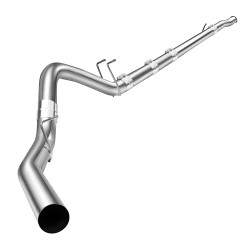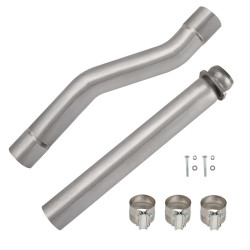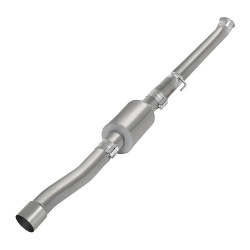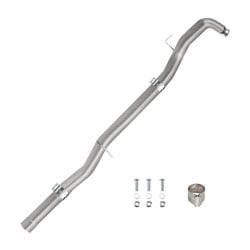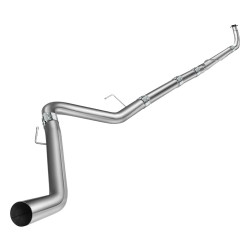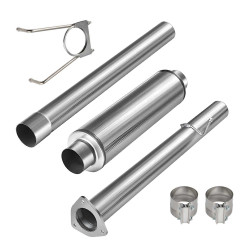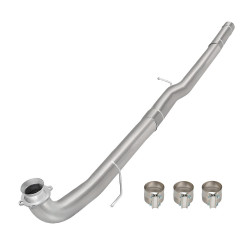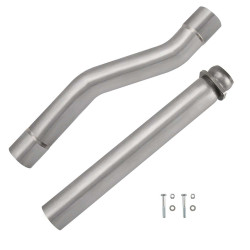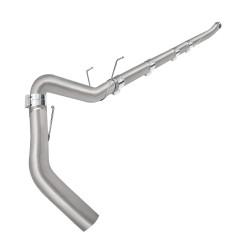Introduction
Modern diesel trucks are engineering marvels, balancing high torque output with increasingly strict emissions regulations. However, the factory exhaust systems—designed to meet these standards—often introduce compromises in performance, reliability, and maintenance costs. Components like the Diesel Particulate Filter (DPF), Diesel Oxidation Catalyst (DOC), and Selective Catalytic Reduction (SCR) systems are complex and prone to clogging or failure over time.
For many diesel owners looking to maximize power, reduce maintenance headaches, and unlock a more reliable driving experience, delete pipes offer a proven solution. In this guide, we’ll take a deep dive into the anatomy of stock diesel exhaust systems, the limitations they introduce, and how upgrading with a delete pipe can transform your truck’s performance and longevity.
What's Inside a Stock Diesel Exhaust System?
For modern diesel trucks like the Powerstroke, Cummins, and Duramax, the factory exhaust system is far more than just piping—it's a complex emissions control system designed to meet strict regulations. Here's a breakdown of the typical components found in a stock diesel exhaust:
-
Diesel Oxidation Catalyst (DOC) Located right after the turbo, the DOC's job is to oxidize carbon monoxide (CO), hydrocarbons (HC), and some particulate matter. It's the first emissions control component in line and helps prepare the exhaust gases for treatment downstream.
-
Diesel Particulate Filter (DPF) This large canister is designed to trap and store soot (particulate matter) from the exhaust stream. Over time, the DPF needs to regenerate—burning off the collected soot via high exhaust temperatures or injected fuel, which can reduce efficiency and performance.
-
Selective Catalytic Reduction (SCR) Common in later-model trucks, this system injects DEF (Diesel Exhaust Fluid) into the exhaust to reduce NOx emissions. It works alongside a special SCR catalyst further down the exhaust.
-
NOx Sensors & Temperature Sensors Multiple sensors are placed along the exhaust system to monitor emissions performance and trigger regeneration or warning lights. These are critical to the function of the DPF and SCR systems.
-
Muffler / Resonator Near the end of the system, a muffler or resonator helps quiet down exhaust noise, especially during regeneration cycles when temps and pressure can spike.
Up next, we'll dive deeper into the Diesel Particulate Filter (DPF) — the component that diesel truck owners often find most frustrating.
Deep Dive into the Diesel Particulate Filter (DPF)
What Is a DPF and How Does It Work?
A Diesel Particulate Filter (DPF) is a flow‑through ceramic or metal substrate designed to trap and store microscopic soot particles (PM) generated by the combustion process. Instead of allowing these particulates to pass directly into the atmosphere, the DPF's honeycomb structure alternately blocks and channels exhaust flow, capturing soot much like an air purifier's filter captures household dust and pollen.
Analogy: Think of your home air cleaner—its filter media captures airborne particles through a mesh of tiny passages. A DPF works on exactly the same principle, only under much higher temperatures and pressures.
Regulatory Origin and Fitment Timeline
DPFs did not exist on early diesel trucks. They were introduced as a direct response to tightening emissions regulations:
In the United States, the EPA's 2007 model‑year heavy‑duty diesel standards mandated that all new on‑road diesels meet ultra‑low particulate emissions, effectively requiring a DPF. (These regulations applied to engines built for the 2007 model year, which began production in late 2006.)
Because of this, most US diesel pickups and commercial trucks manufactured from 2007 onward are factory‑equipped with a DPF.
DPF as a Wear‑Item: Why It Needs Regeneration and Replacement
Just like an air‑purifier filter eventually clogs and needs changing, a DPF is semi‑consumable:
-
Active Regeneration
-
Modern vehicles perform an active regen by injecting a small amount of extra fuel or using an electric heater to raise the DPF's internal temperature above ~1,100°F(600°C ).
-
At this temperature, trapped soot ignites and oxidizes to CO₂, clearing most of the accumulated material.
-
Residual Ash (Non‑Burnable Solids)
-
Regeneration removes the carbonaceous soot, but leaves behind inorganic ash from engine oil additives and fuel impurities.
-
Over tens of thousands of miles, ash accumulates inside the filter channels, gradually reducing filter porosity and increasing back‑pressure.
-
Service Interval & Replacement
-
Unlike passive (temperature‑driven) regen that happens during normal highway driving, forced regens (initiated by the engine control unit) may be required if the vehicle sees a lot of low‑speed or stop‑and‑go duty. When soot buildup overwhelms the DPF, you’ll need a technician (or a properly equipped DIYer) to connect an OBD2 scanner and command a forced DPF regeneration.
-
When ash load exceeds the DPF's design capacity—typically after 100,000–150,000 miles—professional cleaning or full DPF replacement becomes necessary to prevent engine derate or warning lights.
Why Delete Pipes Exist and What They Really Do
We've gone deep into how the DPF (Diesel Particulate Filter) works, and for good reason: DPF clogging is one of the most frustrating pain points for diesel truck owners. Once it clogs, you're either spending money on professional cleaning—or worse, replacing it altogether. That's where delete pipes come in.
In reality, most delete pipes on the market aren't just designed to remove the DPF alone. Instead, they usually eliminate multiple emissions components all at once—DOC (Diesel Oxidation Catalyst), DPF, and sometimes even the SCR system. So, when you see a product labeled as a “DPF delete pipe” or “DOC/DPF delete,” what you're really looking at is a section of exhaust pipe that replaces the entire emissions control segment of the system.
In diesel engines, the Diesel Oxidation Catalyst (DOC) performs a function similar to a gasoline catalytic converter. Therefore, when you hear ‘CAT delete’, it typically refers to removing the DOC (and sometimes other emission components) rather than a traditional catalytic converter. But in diesel circles, the term "CAT" has become a kind of industry shorthand for anything catalytic, especially since it's more familiar to most truck owners. That's why many sellers use “CAT delete” to refer to DOC delete pipes. It's not technically accurate, but it's widely understood.
Beyond partial deletes, there's also the option of a full exhaust system replacement. These setups typically include a long section of straight pipe that completely removes DOC, DPF, SCR, and even the muffler in some cases. This is often referred to as a "straight pipe system." It's a popular option for those whose original exhaust has rusted out, or when bolts and clamps are too corroded to remove just one section. In those situations, replacing the entire exhaust at once can actually save time and hassle.
And for those concerned about noise, some full systems come equipped with a muffler section to tone things down. That way, you get the performance benefits of a delete system without waking up the neighborhood.
Benefits of a Delete Pipe Upgrade
Upgrading to a delete pipe offers diesel‑truck owners several tangible advantages:
-
Saving Money—Improved Fuel Economy & Lower Maintenance Costs
-
Eliminate DPF headaches: Removing the DPF removes the risk of clogs that cause limp-home mode, forced regen events, or expensive full-filter replacements.
-
Better combustion efficiency: A free‑flowing exhaust means less back‑pressure, so your engine can intake fresh air more easily and burn fuel more completely—no more phantom “regen” fuel dumps that erode your MPG.
-
Long‑term savings: Fewer regen cycles and zero DPF cleanings or replacements translate directly into lower service bills and reduced downtime.
-
Lower Back-Pressure
By removing restrictive components like the DOC, DPF, and SCR, exhaust gases can exit the engine more freely. This reduces back-pressure, allowing more fresh air (and oxygen) into the combustion chamber. As a result, the engine achieves stronger and more complete combustion — especially at high RPMs, with noticeably sharper throttle response, higher horsepower, and increased torque.
-
Better Thermal Management
With fewer restrictions in the exhaust path, high-temperature combustion gases are expelled more quickly, helping to avoid heat build-up in the exhaust system. This faster gas flow lowers the overall thermal load under the hood, helping nearby components stay cooler and reducing long-term heat-related wear—particularly valuable on long hauls or in hot climates.
-
Enhanced Driving Experience–Immediate Throttle Response & Aggressive Exhaust Tone
With a straight-through exhaust path, throttle response becomes more immediate—every press of the pedal delivers quicker acceleration and a stronger connection between the diesel driver and the machine. As the RPM climbs, so does the excitement: the deep, aggressive roar from the tailpipe turns heads and perfectly matches the power you feel behind the wheel. It’s not just performance—it’s a more visceral, rewarding driving experience.
Find the Right Delete Pipe or Full Exhaust System for Your Truck
Browse this page to find the delete pipes or full exhaust systems that fit your specific diesel platform. Whether you're upgrading a worn-out stock setup or looking for maximum airflow, we've got you covered.
Delete Pipe Legal Notice
Please follow all local emissions laws and regulations. These products are intended for off-road use only, such as closed-course racing or competition vehicles.
